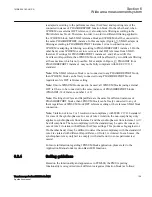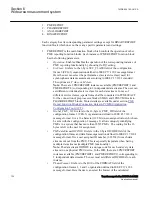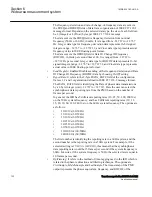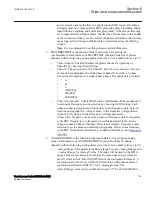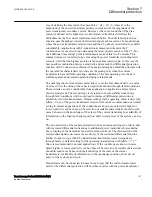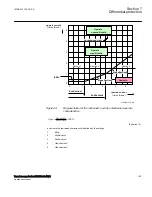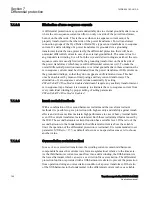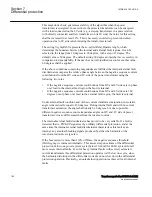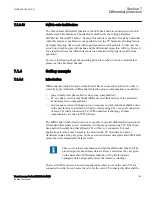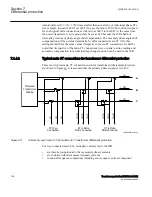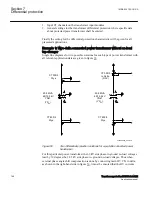
This magnitude check, guarantees stability of the algorithm when the power
transformer is energized. In cases where the protected transformer can be energized
with a load connected on the LV side (e.g. a step-up transformer in a power station
with directly connected auxiliary transformer on its LV side) the value for this setting
shall be increased to at least 12%. This is necessary in order to prevent unwanted
operation due to LV side currents during the transformer inrush.
The setting
NegSeqROA
represents the so-called Relay Operate Angle, which
determines the boundary between the internal and external fault regions. It can be
selected in the range from 30 degrees to 90 degrees, with a step of 1 degree. The
default value is 60 degrees. The default setting 60 degrees somewhat favors security in
comparison to dependability. If the user has no well-justified reason for another value,
60 degrees shall be applied.
If the above conditions concerning magnitudes are fulfilled, the internal/external fault
discriminator compares the relative phase angle between the negative sequence current
contributions from the HV side and LV side of the power transformer using the
following two rules :
•
If the negative sequence currents contributions from HV and LV sides are in phase
or at least in the internal fault region, the fault is internal.
•
If the negative sequence currents contributions from HV and LV sides are 180
degrees out of phase or at least in the external fault region, the fault is external.
Under external fault condition and with no current transformer saturation, the relative
angle is theoretically equal to 180 degrees. During internal fault and with no current
transformer saturation, the angle shall ideally be 0 degrees, but due to possible
different negative sequence source impedance angles on HV and LV side of power
transformer, it may differ somewhat from the ideal zero value.
The internal/external fault discriminator has proved to be very reliable. If a fault is
detected, that is, PICKUP signals set by ordinary differential protection, and at the
same time the internal/external fault discriminator characterizes this fault as an
internal, any eventual blocking signals produced by either the harmonic or the
waveform restraints are ignored.
If the bias current is more than 110% of IBase, the negative sequence threshold
(
IMinNegSeq
) is increased internally.. This assures response times of the differential
protection below one power system cycle (below 16.66mS for 60 Hz system) for all
more severe internal faults. Even for heavy internal faults with severely saturated
current transformers this differential protection operates well below one cycle, since
the harmonic distortions in the differential currents do not slow down the differential
protection operation. Practically, an unrestrained operation is achieved for all internal
faults.
Section 7
1MRK 504 163-UUS A
Differential protection
142
Transformer protection RET670 2.2 ANSI
Application manual
Содержание RELION RET670
Страница 1: ...RELION 670 SERIES Transformer protection RET670 Version 2 2 ANSI Application manual ...
Страница 2: ......
Страница 48: ...42 ...
Страница 64: ...58 ...
Страница 74: ...68 ...
Страница 104: ...98 ...
Страница 194: ...188 ...
Страница 518: ...512 ...
Страница 618: ...612 ...
Страница 648: ...642 ...
Страница 666: ...660 ...
Страница 672: ...666 ...
Страница 682: ...676 ...
Страница 844: ...838 ...
Страница 868: ...862 ...
Страница 956: ...950 ...
Страница 964: ...958 ...
Страница 1004: ...998 ...
Страница 1014: ...1008 ...
Страница 1015: ...1009 ...


